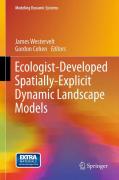
Ecologist-developed spatially-explicity dynamic landscape models
Westervelt, James
Cohen, Gordon
This book is written for ecologists interested in capturing their understandings of how natural systems work in software – to help inform their work and communicate the consequences of proposed management plans. Historically, ecologists had to rely on the skills of trained computer programmers to modeling natural systems, but now a new generation of software is allowing ecologists to directly capture their understandings of systems in software. This book is a compilation of spatially explicit simulation models developed by ecologists andplanners without any formal computer programming skills. Readers will be inspired to believe that they too can create similar models of the systems with which they are familiar. Written for ecologists to help inform their work and communicate the consequences of proposed management plans. A compilation of spatially explicit simulation models developed by ecologists and planners without formal computer programming skills. Some models are the result of professional efforts accomplished in the course of landscape research. INDICE: Preface. Foreword. Never Fear--You Already Model!. A CollaborativeProcess for Multidisciplinary Group Modeling Projects. An Introduction to theNetLogo Modeling Environment. A Simulation Model of Fire Ant Competition withCave Crickets at Fort Hood, Texas. Spatially Explicit Agent-Based Model of Striped Newt Metapopulation Dynamics Under Precipitation and Forest Cover Scenarios. Forecasting Gopher Tortoise Distribution and Long-Term Viability at Fort Benning, Georgia. Using Demographic Sensitivity Testing to Guide Management for Gopher Tortoises on Fort Stewart, Georgia. A Model for Evaluating Hunting and Contraception as Feral Hog Population Control Methods. Spatially Explicit Modeling of Productivity in Pool 5 of the Mississippi River. Simulating Gopher Tortoise Populations in Fragmented Landscapes: An Application of the FRAGGLE Model. An Individual-Based Model for Metapopulations on Patchy Landscapes – Genetics and Demography (IMPL-GD). An Implementation of the Pathway Analysis Through Habitat (PATH) Algorithm Using NetLogo. A Technique for Rapidly ForecastingRegional Urban Growth. Modeling Intimate Partner Violence and Support Systems. Index.
- ISBN: 978-1-4614-1256-4
- Editorial: Springer New York
- Encuadernacion: Cartoné
- Páginas: 162
- Fecha Publicación: 30/01/2012
- Nº Volúmenes: 1
- Idioma: Inglés
